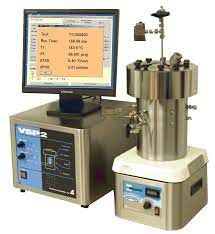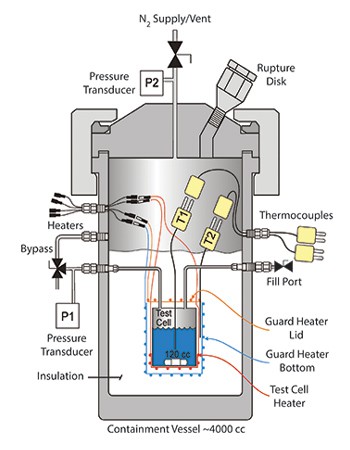Vent Sizing Package 2 (VSP2)




VSP2
Vent Sizing Package 2 (VSP2)
The Vent Sizing Package 2 (VSP2™) is the premier low thermal-inertia (low phi-factor) adiabatic calorimeter used for process hazard characterization. The VSP2 utilizes established DIERS technology to obtain critical safety data used to ensure safe process design. It is the commercial version of the original DIERS bench scale apparatus invented at FAI. We use the VSP2 every day in our fully equipped thermal hazards laboratory, and we also manufacture the instrument and support its use by colleagues around the world.
Vent Sizing Package 2 (VSP2)
| Product number | VSP2 |
The Vent Sizing Package 2 (VSP2™) is the premier low thermal-inertia (low phi-factor) adiabatic calorimeter used for process hazard characterization. The VSP2 utilizes established DIERS technology to obtain critical safety data used to ensure safe process design. It is the commercial version of the original DIERS bench scale apparatus invented at FAI. We use the VSP2 every day in our fully equipped thermal hazards laboratory, and we also manufacture the instrument and support its use by colleagues around the world.
The Vent Sizing Package 2 (VSP2™) is the premier low thermal-inertia (low phi-factor) adiabatic calorimeter used for process hazard characterization. The VSP2 utilizes established DIERS technology to obtain critical safety data used to ensure safe process design. It is the commercial version of the original DIERS bench scale apparatus invented at FAI. We use the VSP2 every day in our fully equipped thermal hazards laboratory, and we also manufacture the instrument and support its use by colleagues around the world.
The VSP2 can be thought of as a bench scale chemical reactor contained within a protective containment vessel. Liquid or gaseous reactants can be added to (or withdrawn from) the test cell at any time during an experiment. Tests can be run in true adiabatic mode, with added external heating, or with external cooling. The cylindrical geometry of the test cell is ideal for reactions which require good agitation. Test cells are custom-made in a variety of materials and configurations to better simulate the process conditions.
VSP2 tests can be run in open cell mode (typical for very gassy systems) or in closed cell mode where the thin-walled test cell is kept intact by automatic pressure-balancing. Closed cell operation provides continuous pressure-temperature data during a runaway reaction, information which is necessary for detailed vent sizing calculations and which can be otherwise difficult to determine. Closed cell tests also require less post-test cleanup.
The sample size in the VSP2 (typically 80 ml) provides for a representative sample as well as good accuracy when adding ingredients that make up a small percentage of the mixture (e.g., catalyst additions). Temperature can be measured at up to three locations in the test cell, a useful option when testing solids or immiscible liquids. A baffled test cell with either a “star” stir-bar or a mechanical agitator can be used for optimal mixing of multiphase reactions, such as for emulsions, suspensions, or slurries. For true adiabatic operation (i.e., with low phi-factor and without externally imposed heating) the VSP2 is usually preferred. Polymer and multi-phase systems are particularly well suited to the VSP2 because of the excellent agitation and continuous vapor pressure measurement.
Its versatile and innovative design allows the VSP2 to simulate any number of upset (abnormal) conditions which might lead to a runaway chemical reaction (e.g., loss of cooling, loss of stirring, mischarge of reagents, mass-loaded upset, batch contamination, fire exposure heating, etc.). VSP2 data yield critical rates of temperature and pressure rise during a runaway reaction, thereby providing reliable energy and gas release rates which can be applied directly to full scale process conditions.
The VSP2 typically utilizes a sample size of 40-100 grams in a lightweight metal test cell with a volume of approximately 120 ml. The test cell is surrounded by a heater which is used to maintain adiabatic conditions during an experiment. This test cell and heater assembly is placed in a 4L containment vessel. Tests are typically performed as a closed system, so that vapor pressure data can be directly measured throughout the runaway
Features and Applications
The versatile VSP2 design lets you directly simulate most process upset conditions including:
Many testing configurations to accommodate a range of applications including:
VSP2 data allow you to completely characterize chemical reaction hazards and determine key process safety parameters including:
The versatile VSP2 design lets you directly simulate most process upset conditions including:
- Loss of cooling or agitation
- Accumulation or mischarge of reactants
- ontamination of batch
- Thermally initiated decomposition
- Resident incubation time
Many testing configurations to accommodate a range of applications including:
- Solids, liquids or two-phase mixtures
- In-situ liquid/gas dosing or sampling
- Closed or open (vented) tests
- Scaled blowdown simulation
- Two-phase flow regime determination
- Test cells are available in 304 & 316 SS, Hastelloy C, Titanium and glass
VSP2 data allow you to completely characterize chemical reaction hazards and determine key process safety parameters including:
- Required size of emergency relief system (ERS)
- Adiabatic temperature and pressure rise rates (dT/dt, dP/dt)
- Total adiabatic temperature rise (ΔTad)
- Heat of reaction or mixing
- Vapor pressure data
- Time- to-maximum rate (TMR)
- Temperature of no return (TNR)
- Self-accelerating decomposition temperature (SADT)

